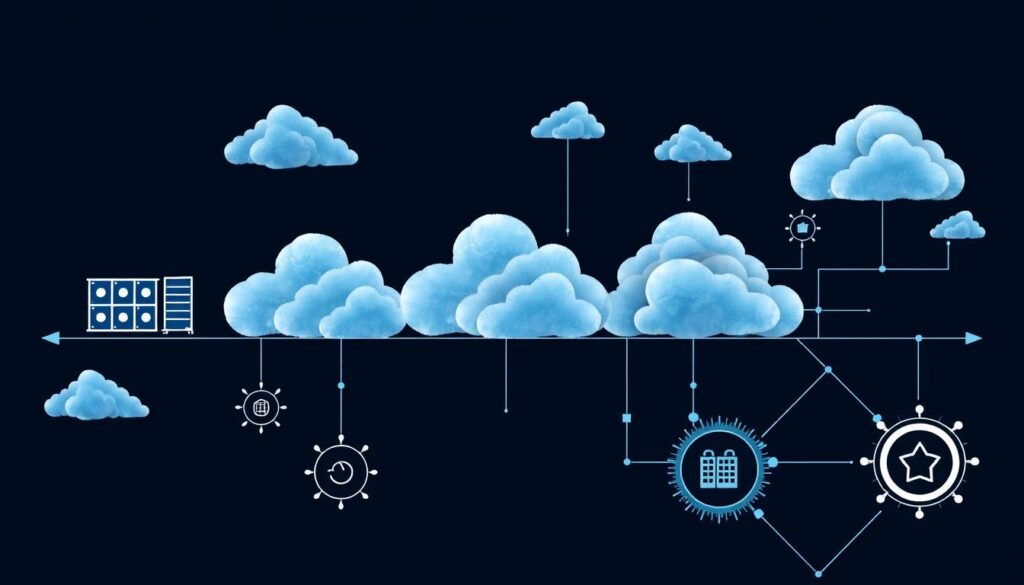The world of web development is changing fast with serverless architectures. As we are in 2025, using serverless tech is key for new web development ideas. It makes websites faster, more scalable, and cheaper to run.
Serverless web development lets developers write code without worrying about servers. This is great for quick and easy website growth. With new serverless web development, online sites will soon be more efficient and lively than ever.

Key Takeaways
- Serverless architectures are shifting the landscape of web development.
- Benefits include improved speed, scalability, and lower operational costs.
- Developers can focus on code, removing the necessity for server management.
- The future of web platforms will be shaped significantly by serverless technology trends.
- 2025 promises innovations in serverless web development that enhance efficiency and dynamism.
Introduction to Serverless Web Development
Serverless web development is a big change in cloud computing. It lets developers build and deploy web apps easily. They don’t have to worry about the tech behind it.

What is Serverless Computing?
Serverless computing is a way to use the cloud without managing servers. Cloud providers handle the tech stuff. This lets developers focus on coding and reduces work.
It makes apps run better and saves money. Users only pay for what they use. This makes apps scale well and work fast.
Benefits of Serverless Architecture
Serverless architecture has many benefits. It saves money because users only pay for what they use. It also makes apps scale well, handling more users easily.
Another big plus is it lets developers work faster. They can focus on making new things instead of managing servers.
Why Choose Serverless for Web Development?
Developers choose serverless for good reasons. It lets them deploy apps quickly and easily. This is great for modern web apps.
By using serverless web development, developers can make faster, better websites. These websites meet today’s digital needs.
Key Components of Serverless Architecture
In a serverless architecture, we focus on specific components that make development easier. Functions as a Service (FaaS) and Backend as a service (BaaS) are key. FaaS, like AWS Lambda, lets developers run code without worrying about servers. This is vital for building apps that grow and scale well.

Backend as a service (BaaS) makes things simpler by giving ready-to-use services. These include databases, authentication, and updates in real-time. Firebase and Auth0 are well-known BaaS providers. They help developers create great front-end experiences.
APIs are also important, connecting different serverless parts. They make sure everything works together smoothly. This creates a system that’s both fast and strong.
Event-driven data sources are also essential. They include message queues and streams. These sources start serverless functions, making sure data and actions are handled on time. Together, these parts form a complete serverless system. It frees developers from server worries, letting them focus on what matters most.
Deploying With AWS Lambda
Using AWS Lambda for app deployment is a smart move. It lets developers run code without worrying about servers. We’ll cover the basics, common uses, and tips for better deployments.
Getting Started with AWS Lambda
To start with AWS Lambda, first, make an AWS account. Then, go to the Lambda Management Console. Click “Create function” to begin.
Choose a blueprint or start from scratch. Name your function and pick a runtime. Set memory and time-out options for your function. Choose how to start it, like HTTP requests or S3 uploads.
Review and create your function. Now, you’re ready to manage your deployments well.

Use Cases for AWS Lambda
AWS Lambda is great for many things. It’s perfect for scalable web apps, real-time file processing, and data tasks. For web apps, it works with Amazon API Gateway for serverless APIs.
For file processing, its scaling handles data streams from Amazon Kinesis. It’s also good for data transformation tasks with services like Amazon S3 and DynamoDB.
Best Practices for AWS Lambda Deployment
To make AWS Lambda deployments better, follow some key steps. First, allocate resources wisely to avoid waste. Use AWS CloudWatch Logs to check your function’s performance and adjust resources if needed.
Also, ensure strong security with IAM roles and limited permissions. To save costs, track expenses with AWS Lambda’s tools. Lastly, use automated scaling for reliable performance.
Building Web Applications with Cloud Functions
Serverless app architecture has changed how we build web apps. It makes them more scalable, efficient, and cost-effective. Cloud Functions are key in this, helping with dynamic content and backend tasks without server management.
Introduction to Cloud Functions
Cloud Functions are small, event-driven pieces of code. They run when something happens, like a user action or service update. They scale up or down as needed, making them great for background tasks and improving app performance.
By using cloud-based microservices, Cloud Functions keep apps fast and flexible. They adapt well to changing demands.
Integrating Cloud Functions into Your Web App
Adding Cloud Functions to your web app lets you run code on demand. You set up triggers for specific events, like user actions or database changes. This way, Cloud Functions can handle many tasks, from user input to complex API requests.
This ensures your app works smoothly and performs well in real-time.
Optimizing Performance with Cloud Functions
Improving Cloud Functions’ performance is key for fast web apps. Good coding, state management, and avoiding cold starts are important. Efficient code and smart state management cut down on execution time and resource use.
Techniques like warm-up tasks also boost performance. They help your app respond quickly in a serverless setup.

Event-Driven Programming in Serverless Environments
Event-driven architecture is key in serverless environments. It lets functions start and grow based on events. These events can be user actions, sensor data, or messages from other apps.
This architecture is great for handling real-time data. It makes apps respond quickly to different triggers.
Serverless computing automates resource use, saving time and money. Functions can start with HTTP requests, database changes, or scheduled tasks. This makes development easier.
Real-time data handling is vital in serverless setups. It lets apps process data as it comes in. This is super useful for IoT or live analytics.
Using event-driven architecture boosts scalability and innovation in serverless computing. It makes apps more dynamic and efficient. They can handle user actions and data streams smoothly.
The Role of Microservices in Serverless Web Development
Microservices are key to making serverless web development more efficient. They break down apps into smaller, independent services. This fits well with serverless computing, helping developers create strong, flexible apps.
What are Microservices?
Microservices are separate services that work together to make a full app. Each one handles a specific task, making it simpler to update and grow. They talk to each other through APIs, which makes the system more flexible and easy to change.
Advantages of Using Microservices
Using microservices in serverless web development has many benefits. First, it makes apps more agile, allowing for quick updates and new features. This is great for fast-paced projects.
Second, microservices make apps more resilient. If one service has a problem, it won’t affect the whole app. Lastly, they make maintenance easier because each service is separate. This helps with continuous updates and growth in large systems.
Popular Serverless Frameworks to Know in 2025
Serverless web development is growing fast, and picking the right framework is key. Frameworks make serverless web development easier to deploy and manage. This makes serverless computing open to more developers. We’ll look at the top serverless tools of 2025, highlighting their strengths and what’s best for your project.
Introduction to Serverless Frameworks
Serverless frameworks offer a structured way to build and deploy apps. They simplify deployment by hiding infrastructure details. Frameworks like the Serverless Framework, AWS Chalice, and Apex are popular for their tooling and cloud service support.
Comparison of Top Serverless Frameworks
Comparing serverless platforms is key to understanding their features and limits. The Serverless Framework is known for its wide plugin support and cloud provider compatibility. AWS Chalice excels with Python apps, integrating well with AWS Lambda. Apex is great for projects needing Golang support, with a focus on simplicity and performance.
Choosing the Right Framework for Your Project
Choosing a framework depends on your project’s needs. For example, the Serverless Framework is good for projects needing to work on multiple clouds. AWS Chalice is ideal for Python projects that need AWS Lambda integration. Apex is perfect for those who value simplicity and performance, with Golang support.
Scalability and Flexibility in Serverless Web Development
Serverless web development is changing how we build and scale apps. It uses auto-scaling solutions for unmatched flexibility and efficiency.
Managing Scalability
Serverless apps adjust to changing workloads on their own. This means resources are used well, keeping costs low and uptime high. When traffic spikes, auto-scaling solutions jump in, keeping performance smooth without human help.
Flexibility Benefits in Serverless
Serverless web development is super flexible. Developers can quickly respond to market changes and user needs. With agile development, teams can roll out new features fast, staying ahead of the competition.
Real-Life Case Studies of Serverless Websites
Looking at real-life serverless web development success stories can give us great insights. They show how serverless web development can improve performance and cut costs. These projects have made a big impact in e-commerce, media, and finance.
Successful Serverless Web Projects
Netflix is a great example of using serverless architecture. They used AWS Lambda for their backend, making their system scalable and efficient. This move improved performance and lowered costs.
Coca-Cola also made a smart move by using serverless for vending machines. They used serverless functions to manage user data and transactions. This made their system more responsive and scalable, improving user experience worldwide.
Lessons Learned from Case Studies
These examples teach us a lot. Serverless web development can save a lot of money, like A Cloud Guru did by cutting costs by 40%. It also makes developers more productive by taking away the need to manage infrastructure.
The media industry also benefits from serverless. The Financial Times, for example, made their content delivery faster and more reliable. This helped them handle high traffic during busy news times.
These stories show that serverless projects are not just possible but also very beneficial. They help grow technology and businesses in many ways.
Common Challenges with Serverless Web Development
Serverless web development offers big benefits but also faces unique hurdles. These mainly come from latency and security issues. Both need careful handling.
Latency Issues
Latency is a big worry in serverless setups, mainly because of cold starts. Cold starts happen when a function is called after it’s been idle for a while. This causes delays. To tackle this, developers need to fine-tune their apps and function settings.
Using hybrid architectures can also help. This approach mixes serverless functions with traditional computing. It aims to improve performance and reduce latency.
Security Considerations
Security in serverless environments is different from traditional servers. Companies must use secure coding to fight threats like injection attacks and data leaks. Tools and services focused on security help manage risks.
Keeping dependencies up to date and following best practices also boosts security. This makes applications more secure.
Understanding and tackling these challenges helps developers work better with serverless architecture. They can build more reliable apps.
Best Practices for Serverless Web Development
Serverless web development has changed how we build apps. It removes the need for server management. To get the most out of it, we need to follow best practices. These practices help us use resources well and keep costs down.
Ensuring Efficient Development
Being efficient starts with the DRY principle. It helps avoid repeating code and makes it easier to maintain. Using automated tools for deployment, monitoring, and scaling makes things smoother.
Tools like AWS CloudFormation or Terraform help manage infrastructure. This ensures resources are used right.
Maintaining Cost-Effectiveness
To keep costs low, we need to watch and adjust things often. Use tools like AWS CloudWatch to keep an eye on how functions perform. Changing memory and execution times can save money without hurting performance.
Regularly reviewing and tweaking our strategies is key. This helps avoid wasting money and keeps resources used effectively.
Future Trends in Serverless Web Development
The world of serverless web development is changing fast. To stay ahead, it’s key to know the latest tech trends. New tech like AI, edge computing, and IoT will change how we develop websites.
Technological Advances to Watch
Several new tech advancements are worth watching. AI and machine learning can do tasks for us, making development faster. Edge computing makes websites load quicker by bringing resources closer to users.
IoT devices will also make web apps more interactive and powerful.
Predictions for 2025 and Beyond
Looking ahead, serverless computing will see big changes. Web development tools will get better, making work easier and faster. Apps will work better on different devices and systems.
New cloud service providers will also come up. They’ll offer fresh solutions for serverless web development.
Conclusion
Serverless web development is leading the web development revolution. It offers huge benefits for developers and businesses. By looking at AWS Lambda and Cloud Functions, we see how it makes operations smoother and faster.
Working with microservices and using popular frameworks shows its power. It makes our web projects scalable and flexible.
But, there are challenges in embracing serverless innovation. We must manage latency and security issues. Knowing the best practices helps us work efficiently and save costs.
Real-life examples and future trends guide us. They show why we need to get ready for a serverless future. Learning and adapting quickly is key in this fast-changing field.
Serverless technology is very important for web development in the future. As we move into 2025 and beyond, using serverless innovation is essential. It helps us stay ahead and grow.
By adopting these new methods, developers and businesses can succeed. Get ready for a future where serverless solutions lead the way. They will help us achieve more efficiency and innovation.
FAQs
What is Serverless Computing?
Serverless computing is a cloud model where providers manage resources. It lets developers run code without managing servers. Services like AWS Lambda and Google Cloud Functions make it easy.
What are the benefits of serverless architecture?
Serverless architecture saves costs and simplifies scaling. It reduces complexity and speeds up development. Developers only pay for what they use, focusing on code.
Why choose serverless for web development?
Serverless web development is fast, scalable, and cost-effective. It’s great for dynamic and event-driven apps. Serverless frameworks make it easier for developers to use.
How do Functions as a Service (FaaS) and Backend as a Service (BaaS) fit into serverless architecture?
FaaS and BaaS are key parts of serverless. FaaS, like AWS Lambda, runs functions on demand. BaaS handles backend tasks without server management. Together, they create a full serverless setup.
How do you get started with AWS Lambda?
Start with an AWS account and the Lambda service. Choose a language like Node.js or Python. Define your function, set triggers, and deploy it, using AWS’s scaling.
What are some common use cases for AWS Lambda?
AWS Lambda is used for backend processing, real-time data, and file tasks. It’s good for chatbots, data transformations, and HTTP requests via Amazon API Gateway.
What are best practices for AWS Lambda deployment?
Optimize resources, secure code, and monitor performance. Use AWS CloudFormation for easier deployment. This helps manage versions and aliases.
What are Cloud Functions and how do they operate within serverless architecture?
Cloud Functions are small, event-driven tasks in a serverless setup. They’re provided by platforms like Google Cloud Functions. They handle tasks without managing infrastructure.
How can Cloud Functions be integrated into a web application?
Cloud Functions manage backend tasks in web apps. Set up triggers for HTTP requests or database changes. This connects functions to the app’s frontend.
What is event-driven programming in serverless environments?
Event-driven programming in serverless means writing functions for specific events. This model scales and executes functions automatically, without manual effort.
What are microservices and how do they complement serverless web development?
Microservices are deployable components in an app. In serverless, they offer agility and scalability. They make apps flexible and easier to maintain.
What are some popular serverless frameworks in 2025?
In 2025, expect the Serverless Framework, AWS SAM, and Google Cloud Functions Framework. These frameworks simplify serverless app deployment and management.
How do serverless applications manage scalability?
Serverless apps scale automatically by adjusting to demand. Cloud providers manage resources, ensuring high performance. Developers don’t need to adjust capacity manually.
What are the common challenges with serverless web development?
Challenges include managing latency and security concerns. Optimize function starts and use robust security. Hybrid solutions can also help.

